Twenty-four teams travelled to France for this World Cup and now only four remain. It's been a wild ride to get here and, from the looks of it, the semi-finals won't reign in the wild-ness.
The teams will, undoubtedly, have carried out thorough planning as to how to play against their next opponents, so let's join them and delve into the data to get a sense for how the semi-finalists could play to give them the best chance of getting to the final.
England vs United States
England and the United States will give each other no quarter. The feistiness has started pre-match, with sections of the English press calling the American team arrogant and Phil Neville questioning the etiquette of the USWNT operations personnel taking a look at the hotel England happened to be staying at, should the US want to stay there in the days before the final.
The spice that those add will mostly be off-field, in the newspapers and commentary booths, but on-field these are two of the most intense counterpressing teams when they lose the ball. Both are in the top five for the rate at which they chase down turnovers they lose. Tuesday's match could be frenetic.
There is are nuanced differences in the way each team does this, though. The Lionesses hunt in packs; Neville's team are second in the World Cup for highest percent of their counterpresses that feature more than one player doing the pressing (29.2%). The English press might think the United States overly bombastic but, in only counterpressing with multiple players 16.9% of the time, they look relatively tame in comparison.
Ellen White leads the line for England, in and out of possession. As one of the joint-top scorers in the competition it's no surprise that she's caught the eye, but her defensive workrate is equally off the charts. With 16.75, she has the most pressures in the final third per appearance, giving opposing defenders absolutely no rest. Four-game radar charts usually aren't advised, but White's earned an exception:
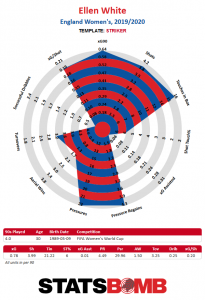
Meanwhile, adding to the narrative around the match is the fact that Megan Rapinoe is the key cog in the American side. She's the player that the USWNT have targeted most with their passes during the two knock-out matches, with 111. England won't be heartened by this, but the next names on the list also give a sense of how attacking the US have been.
Rapinoe is followed by striker Alex Morgan (89), then midfielder Sam Mewis (86), and only then do you get a defender, Abby Dahlkemper with 68 passes aimed at her.
England, possibly a symptom of having played Cameroon in the round of 16, read very differently. Their top five pass-receivers reads Lucy Bronze (right-back), Millie Bright (centre-back), Keira Walsh (defensive midfielder), Nikita Parris (an attacker!), and Steph Houghton (another centre-back).
With this influence of the back-line in build-up play, it's worrying for England that they're prone to playing the ball to Walsh, the anchor of midfield, under pressure this tournament.
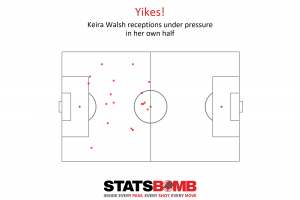
This came to a head against Cameroon (below, red), where many of Walsh's most vulnerable moments occurred.
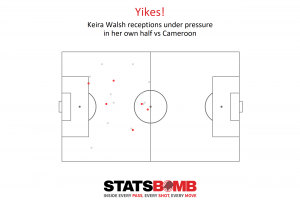
As if all of this wasn't enough to be getting on with, the prospect of Megan Rapinoe and Lucy Bronze going head-to-head on the United States' left/England's right is one to be excited about. It'll be game theory in action - is it best to nullify the other's attacking threat by prioritising defending, or by going on the attack oneself?
For England, the next-biggest problem to solve will be how to build from the back. The United States are more than capable of taking advantage of the Lionesses' shaky moments at the back, but England will be wary of playing long and possibly giving their opponents the ball. Phil Neville, one would assume, will have faith in his own players to survive the pressure of American pressing. But will they?
At the other end of the pitch, if England decide to utilise Ellen White as a non-stop presser then this could be a very odd game, pressing and counter-pressing, the midfield an area where second balls are won more than where passes are made.
It could be hectic. Hold onto your hats.
Netherlands vs Sweden
While the focus will be on the other semi-final, this one could be equally interesting.
Neither team is perfect by any means. Taking penalties out of the equation, the Netherlands only got 0.41 more expected goals in the knock-out rounds than their two opponents, and for Sweden that figure is 0.45. When you're not even half an expected goal better than your opponents over two knock-out games, your place in the semi-final was far from a certainty.
Netherlands are even more of a collection of counterpressing swarmers than England. 31% of their counterpressing ventures include more than one player.
Sweden, though, aren't a team to dwell on the ball much. Out of the eight quarter-finalists, they strung together five or more passes in the same sequence of play the second-lowest amount (28 across the two games). Only Italy made fewer.
This could mean that Sweden will be easier pickings for the Netherlands' press, but it could also mean that the Swedes will just bypass the pressure by going long to their attackers, in particular centre-forward Stina Blackstenius.
[dots represent Blackstenius' position; black = complete, red = incomplete]
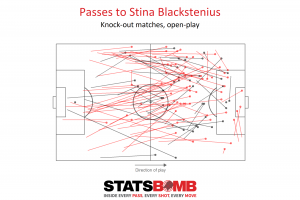
Compare that with the passes that have been aimed in the direction of Netherlands striker Vivianne Miedema. There's still an aspect of direct play, but also a relative abundance of potential receptions around the D or inside the box.
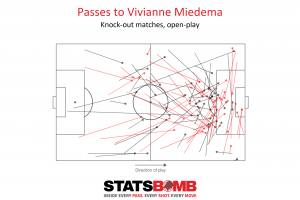
Although the Dutch attack has undeniable quality, they have struggled - particularly in their quarter-final against Italy - to work good shooting opportunities. The average expected goals value of their shots has been just 0.081 in the knock-outs (i.e., an 8% chance), only the sixth-best of the eight teams to make the quarter-finals. Across the tournament as a whole, they've averaged 10.6 completed passes in the final third for every shot they take, the highest of any of the 24 teams.
The two styles - punt it to Blackstenius vs circulate in the final third - will be an interesting clash. The Netherlands, partly as European champions and partly as the team with the greater talent base, will be the favourites. Being the underdogs suited Sweden against Germany, but if the Dutch can get their defensive line in order then they might be able to deal with the direct threat fairly well.
Sweden may choose to direct their long balls on their right, which is where Sofia Jakobsson, scorer against Germany, plays. Out of the two Dutch central defenders, it's left-sided Dominique Bloodworth who looks more vulnerable in the air. Partner Stefanie van der Gragt has averaged 2.83 successful aerial duels per 90 minutes this tournament at a 69% success rate; Bloodworth's averaged 0.74 per 90 with a marginally lower success rate of 67%.
This match will have a different type of ebb and flow to the other semi-final, but which way it ebbs is still uncertain.
